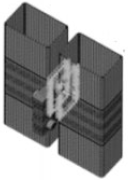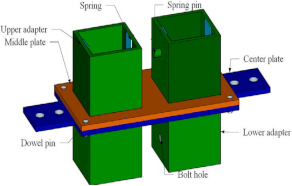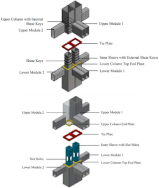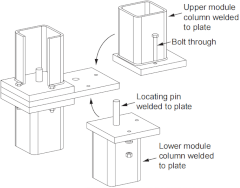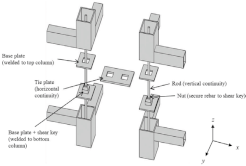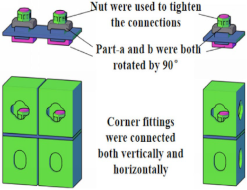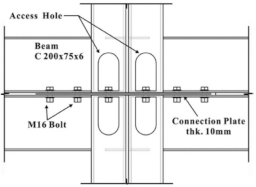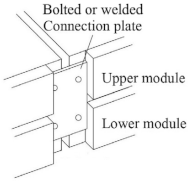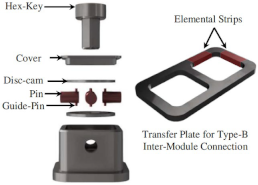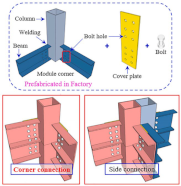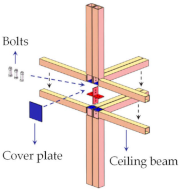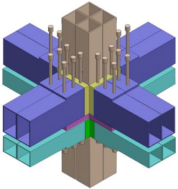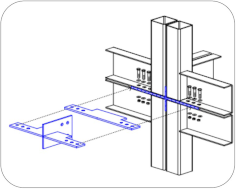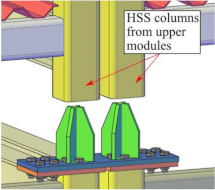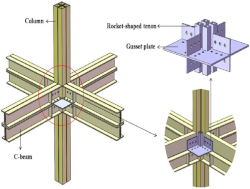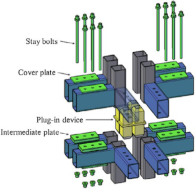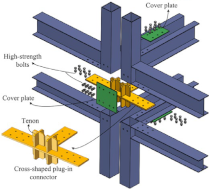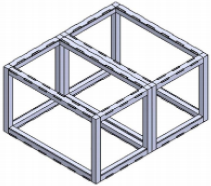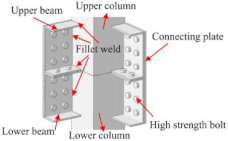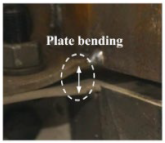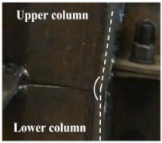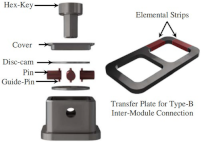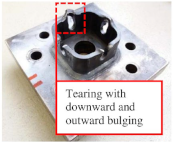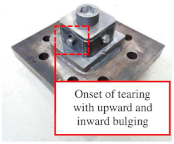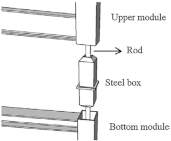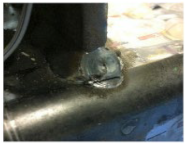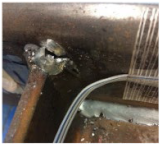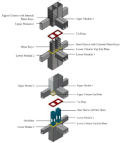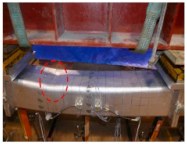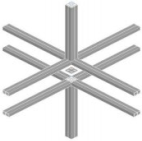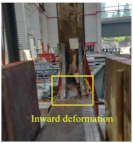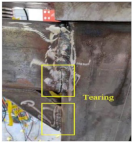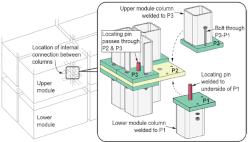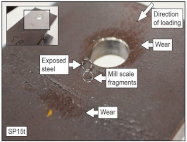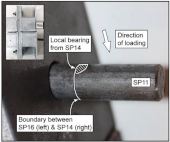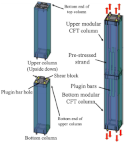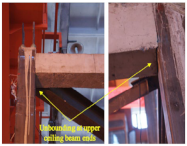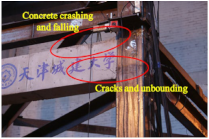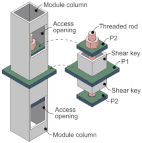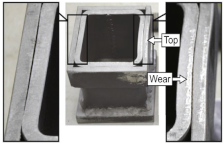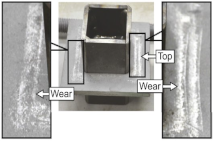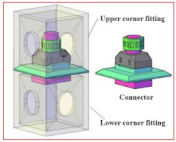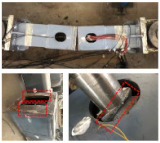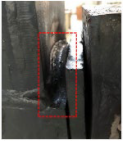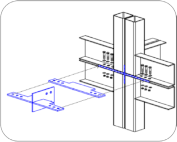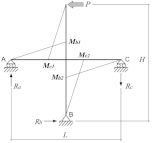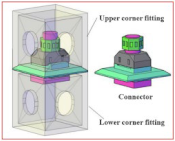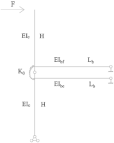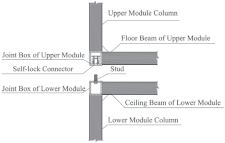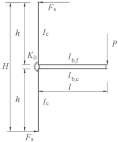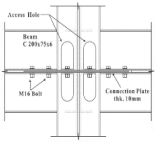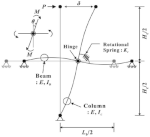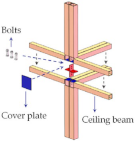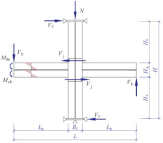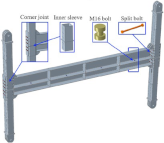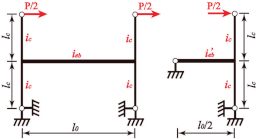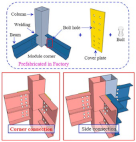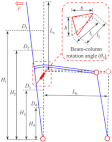Abstract
Modular steel buildings offer the advantages of time-saving construction, reduced on-site work, and less resource waste. The mechanical behavior of modular connections is complex, depending on the type of connecting method and the load-transferring path. The aim of this paper is to offer an overview of the methods for creating inter-module connections. First, we discuss the existing inter-module connections, including vertical connections, horizontal connections, and module-to-concrete-core-wall connections. Then, the mechanical performance and simplified models of the inter-module connections are reviewed in detail; these have a significant influence on the development of modular steel buildings. Finally, the prospects of module-to-module connection are summarized. Despite the increasing amount of research that explores module-to-module connections, fully modular buildings have not yet been achieved, hindering the further development and use of modular steel buildings. In this context, self-locking connections and laminated double-beam connections are proposed, with the aim of promoting the increased use of modular steel buildings.
1. Introduction
Modular steel buildings, which divide traditional architectural connections into three-dimensional modular units, represent an advanced stage in the development of the construction industry. Multiple room-sized modules are prefabricated in factories and transported to the site; they are then hoisted to form a whole structure [1,2,3,4,5], as shown in Figure 1. The method of constructing modular steel buildings has significant technical advantages because of its faster construction speeds, quality assurance, low labor costs, low levels of environmental disturbance, and convenience in recycling as compared to traditional concrete buildings [6,7,8]. However, in some cases, the disadvantages of modular steel buildings can outweigh the advantages; these disadvantages include special design requirements, limited customization options, and high initial investment costs. If the project requires a unique design, customization needs, or greater design freedom, traditional building methods may be more suitable. In addition, modular steel buildings can require significant initial investments, which may impact projects with limited budgets. Therefore, modular steel buildings have become popular and promoted as buildings with repetitive architectural plans and structural layouts, where the advantages of modular construction can be maximized.
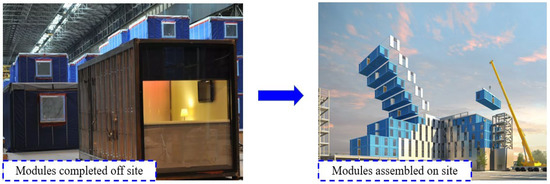
Figure 1.
Modular steel construction.
A modular steel building is a structural system composed of multiple independent modules [9,10,11,12]. There are three typical modules in a modular steel building, depending on the load-transfer mechanism: four-sided modules, corner-supported modules and non-load bearing modules [13,14], as shown in Figure 2. However, module-to-module connections must have sufficient strength and stiffness to ensure that the modules are correctly assembled [15]. Therefore, the carrying capacity of modular steel buildings is closely related to the connections between modules.

Figure 2.
Classification of the modules in modular steel construction. (a) Four-sided modules [14]; (b) Corner supported modules [14]; (c) non-load bearing modules.
The inter-module connection provides a path for load transfer and sharing between modules, which allows the modules to effectively transfer loads to the foundation. Thus, the seismic and bending performance of inter-module connections is crucial. Inter-module connections can be classified as vertical connections, horizontal connections, and module-to-concrete-core connections, as shown in Figure 3. A vertical connection is the connection between modules from different layers, which uses column–column or beam–beam connections. A horizontal connection refers to the connection between adjacent modules from the same layer, which is accomplished by using end plates or plug-ins to connect the columns of adjacent modules together. The connection between the modules and a concrete core wall involves using the concrete core tube as a supporting structure and assembling multiple modules to form an entire building. This type of structural system efficiently resists the lateral force. Generally, vertical and horizontal connections remain a hot topic in the research of inter-module connections. However, the module-to-concrete-core-wall connection is less commonly used in modular buildings due to the larger casting of concrete, which is not in line with the development of modular steel buildings.

Figure 3.
Connections on modular steel building. (a) Vertical connection; (b) Horizontal connection; (c) Modular-to-concrete core connection.
Modular steel buildings are popular in construction due to their unique structural system, and they are mostly used in the construction of low-rise/mid-rise buildings in seismic areas [16,17]. However, some mid-to-high-rise modular steel buildings have been achieved by various projects, e.g., the Raines apartments located in London, UK, a five-story apartment building (Figure 4a) that was one of the earliest modular steel-framed residential buildings [18,19]. The inter-module connections of a five-story dormitory in China (Figure 4b) use the rotational connections proposed by Chen et al. [20]. Meanwhile, 416 Dean, a 32-story apartment building located in New York (Figure 4c) is one of the highest modular steel buildings [19]. A 13-story residence in Tokyo, Japan (Figure 4d), is a hybrid-structured building composed of a concrete core tube and modules [21,22]. These projects demonstrate the feasibility of using modular construction in mid-to-high-rise modular steel buildings. However, despite the current research on inter-module connections can be used in seismic areas, the mechanical behavior of the module connections becomes increasingly crucial as the building height increases; notably, the load-transferring paths and seismic performance of modular steel building are not yet fully understood.
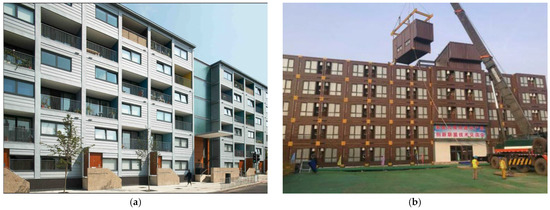
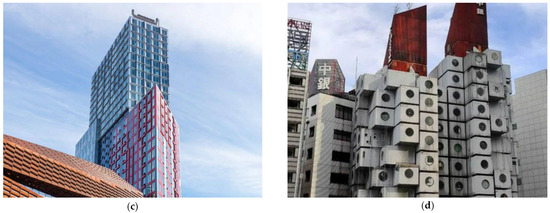
Figure 4.
Modular construction of mid-to-high rise buildings. (a) 6-story apartment in the UK; (b) 5-story dormitory in China [23]; (c) 32-story apartment in the USA; (d) 13-story residence in Japan.
Some studies [7,13,15] have attempted to review the literature on the relationship between the overall performance of modular steel buildings and the design and methods of the connections. Nevertheless, a global analysis of the existing literature on the types of inter-module connection may be helpful in understanding the state of the existing research. This paper presents a comprehensive review of connections in modular steel buildings through a systematic evaluation of connections’ characteristics and mechanical performance, as well as simplified models in modular steel building connections. Finally, the paper presents the current challenges and future research directions for modular steel building connections. The outcomes of this paper are expected to promote the future development of modular steel buildings.
2. Connection Forms in Modular Steel Buildings
2.1. Vertical Module-to-Module Connections
Table 1 shows a schematic presentation of vertical module-to-module connections. As shown in VC1~VC17 in Table 1, bolted connections are the most common type of connection in modular steel buildings, due to their higher strength and rapid manufacturing process, which promote the use of modular buildings [24,25]. They have been used in many regions because of these advantages. In addition, as shown VC17 in Table 1, Xu et al. [26,27] further investigated the bending response of laminated double-channel beams based on bolted connections in modular steel buildings. However, although bolted connections are popular for module-to-module connections, additional operation space is required for installation on-site, and the use of multiple bolts can affect the appearance of modular steel buildings. Therefore, the development of innovative module-to-module connections is one of the main challenges to the promotion and development of modular steel buildings.
Prestressed connections are an attractive solution because they minimize the work requirement; they have been considered by several researchers, as shown in VC18~VC22 in Table 1. Lacey et al. [28] proposed post-tensioned bolted steel connections. Chua et al. [29,30] introduced a rod-base plate-connected connection. Chen et al. [31] presented a pre-stressed modular connection, which had pre-stressed strands vertically connecting the modular columns. Sanches et al. [32] proposed a new vertical post-tensioned connection for modular steel buildings, which consists of a post-tensioned threaded rod installed inside columns of hollow structural sections and a steel box placed between modules. Lacey et al. [33] presented a post-tensioned and interlocking connection in modular steel buildings, which can improve constructability.
As shown by V23 in Table 1, Dai et al. [34] investigated grouted sleeve connections, which do not require bolting or welding to achieve the fast-tracked construction of modular steel buildings. As shown V24~V26 in Table 1, Srisangeerthanan et al. [35] introduced a three-piece boltless connection that can be remotely controlled, allowing for fast, safe, simple, and minimally destructive on-site modular assembly, which is beneficial for achieving a fully modular construction. Dai et al. [36] proposed a plug-in self-lock connection, which does not interfere with the internal finish and installed services. Sharafi et al. [37] described the development of an innovative interlocking system, which can prevent accidental disassembly and stress concentrations at the attachment points in the event of extreme loading occurrence. These connections can make significant improvements to the modular construction industry as it currently exists, enabling the realization of fully modular steel buildings.
Overall, although there is an insistent demand for a deeper understanding of the mechanical performance of module-to-module vertical connections, the related research is still limited. The development of connections between modules is even more challenging, for the following reasons: (1) Easy manufacture and hoisting: inter-module connections should meet the requirements of building industrialization. (2) Sufficient flexural and shear resistance: most modular steel buildings are suitable for non-seismic areas. Flexural and shear forces may occur around the building during earthquakes, and the inter-module connections should be capable of transferring the flexural and shear forces between the modules. Therefore, connections between modules play an important role in modular steel buildings. (3) Ductility and deformation capacity: stress being concentrated on inter-module connections should be avoided. Additionally, most of the vertical connections currently used in modular construction require bolts in on-site installation. However, it is necessary to develop module-to-module connections that are simple, fast, and sufficiently load-bearing, considering the characteristics of modular steel buildings. Self-locking connections can overcome the drawbacks of bolted connections. Thus, the self-locking connection may be a key direction for future research on the vertical connection of modular steel buildings.

Table 1.
Existing vertical connection.
Table 1.
Existing vertical connection.
| Connection Type | Illustration | Connection Type | Illustration |
|---|---|---|---|
| VC1 Bolted connection [38] | 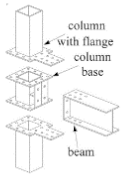 | VC2 Rotary and bolted connection [20,23] | 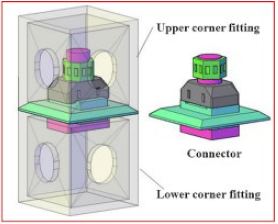 |
| VC3 Bolted connection [39] | 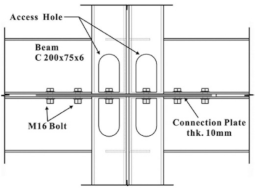 | VC4 Bolted connection [40,41] | 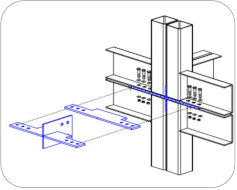 |
| VC5 Long beam bolted connection [42] | 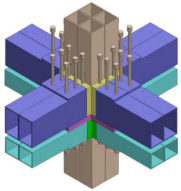 | VC6 Bolted connection [43] | 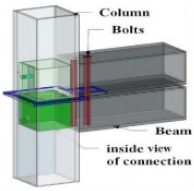 |
| VC7 Bolted connection [44] |  | VC8 Beam-to-beam bolted connection [45,46] | 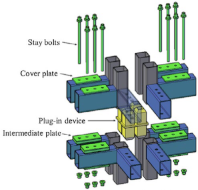 |
| VC9 Bolted connection [47] | 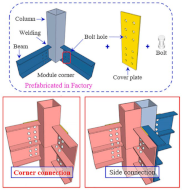 | VC10 Cross-shaped plug-in and bolted connection [48,49] | 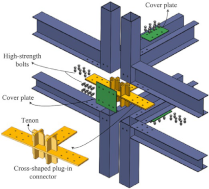 |
| VC11 Bolted and splice connection [50] | 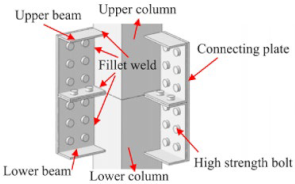 | VC12 Bolted and tenons connection [51] |  |
| VC13 Bolted connection [52] | 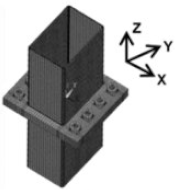 | VC14 Bolted connection [53] | 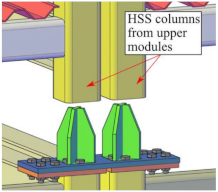 |
| VC15 Bolted and weld connection [54,55,56] | 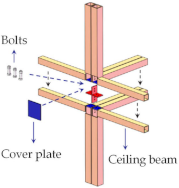 | VC16 Bolted connection [57] | 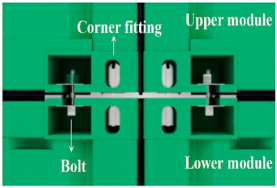 |
| VC17 Bolted and double beams laminated connection [26,27] | 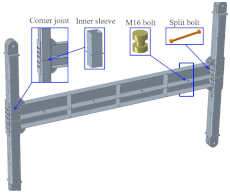 | VC18 Post-tensioned connection [28] | 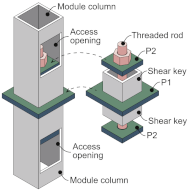 |
| VC19 Rod-base plate connection [29,30] | 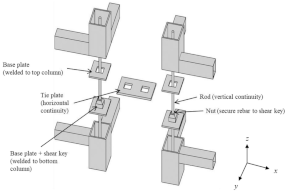 | VC20 Prestressed connection [31] | 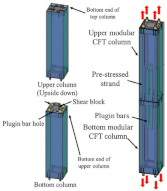 |
| VC21 Post-tensioned connection [32] | 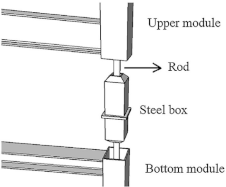 | VC22 Post-tensioned connection [33,58,59] | 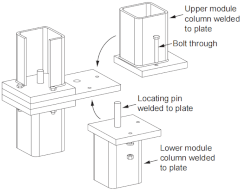 |
| VC23 sleeve connection [34] |  | VC24 Self-locking connection [35] | 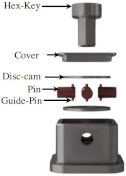 |
| VC25 Self-locking connection [36] |  | VC26 Interlocking connection [37] | 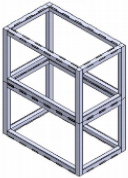 |
2.2. Horizontal Module-to-Module Connections
A horizontal connection between modules is a type of structural connection that connects adjacent modules together. Plate and plug-in connections are widely used for horizontal connections between modules. The plate connections are tightly connected using plates that are inexpensive and facilitate easy on-site installation. The plates are used to fix modules in position and then bolt them together. Plug-in connections utilize plug-ins at the center of the joint to connect adjacent columns and beams. The existing horizontal connections are shown in Table 2. However, additional operation space is required for both types of connection. In addition, HC18 is used an interlocking system for horizontal connections and can avoid these disadvantages. Therefore, the understanding of the horizontal connections between modules is still limited and deserves further research.

Table 2.
Existing horizontal connection.
2.3. Module-to-Concrete Core Wall Connections
Modular hybrid systems are suitable for high-rise modular steel buildings because of their excellent support and seismic capacity. In hybrid structures, concrete core walls are mainly used to resist lateral forces, such as typhoons and earthquakes. Therefore, the connection between the modules and the concrete core is crucial for the overall lateral resistance of the structure. In practical engineering, welding and bolted connections are generally used for the connection between the modules and the concrete core. Choi et al. [64] showed a connection between the module and the concrete core by embedding the stud bolts and the gusset plate, as shown in Figure 5a. Ping et al. [65] used anchor rods and plates to connect the modules to the concrete core, as shown in Figure 5b. However, systematic research should be conducted on the connection between modules and the concrete core wall to determine the load-transferring path between modules and the concrete core wall during earthquakes. The research on modular steel–concrete core structural systems is still unclear due to the limitations of the experiments that have been conducted. Thus, further research of module-to-concrete-core-wall connections is necessary.

Figure 5.
Module-to-concrete core wall connection. (a) Choi et al. [64]; (b) Ping et al. [65].
3. Load Transferring Path and Working Mechanisms
In modular steel buildings, connections between modules are important interfaces for connecting different components and parts [13,66,67]. Therefore, the testing and evaluation of the mechanical performance of these connections are particularly important. Tests typically include four force states: bending, shear, axial tension, and compression. These force states can be simulated using static loading and cyclic loading to obtain parameters such as the moment rotation and load–displacement curve, and the load path and bearing capacity of the connection between modules are evaluated, as shown in Table 3. Static loading can better simulate the displacement of the connection between modules. In addition, cyclic loading can better evaluate the seismic performance of inter-module connections subjected to earthquakes; additionally, it enables the evaluation of energy dissipation capacity, deformation capacity, and failure modes. Therefore, a better understanding of the mechanical properties of the connections between modules is provided through static and cyclic loading tests. The results of these experiments can provide reliable technical support for the design, manufacturing, and use of modular steel buildings.

Table 3.
Modular-to-modular connections.
3.1. Mechanical Behaviors under Static Loading
To evaluate the strength, stiffness, and deformation capacity of module-to-module connections, the load–displacement or moment–rotation curves of column-to-column connections are obtained from static load tests. Some researchers have studied column-to-column connections under static loading. Lyu et al. [50] observed a bilinear profile for load–displacement curves in two directions. The deformation of the entire specimen over 40mm and two different stages in the bending behavior of the splice connection were found. This phenomenon reveals that the connections had adequate bending resistance after the transition from the first stage to the second stage. Lacey et al. [28] established six post-tensioned bolted steel connections. Experimental and numerical investigations of the initial shear load slip behavior were conducted. The results showed that the slip load was effectively controlled by varying the bolt preload and the slip coefficient of the joint surface. Sand blasting the joint surfaces increased the slip coefficient, which produced greater slip resistance. Increasing the bolt preload significantly increased the slip load. Chen et al. [20,23] reported that the moment–rotation curve of the rotating connection member became nonlinear when the load reached 8.5N/m, and the rotational stiffness of the joint continuously decreased with the increasing moment. It decreased sharply after 30 kN/m, and the maximum rotation angle was 8.62°.
In addition, the column–beam joint under static loading has been studied by several researchers. Chen and Khan et al. [42,45,46] established specimens without stiffeners and specimens with stiffeners; their load–displacement curves are shown in Figure 6. The research results show that rib stiffeners can significantly improve the bending stiffness and lateral bearing capacity of the joint connection. The stress concentration in the joint connection area can be effectively reduced by adding rib stiffeners in the area of the connections, preventing holes from occurring and the force transmission paths being changed. In addition, the areas of inter-module connections that use rib stiffeners have better energy dissipation capacity under static loading and can maintain the integrity and stability of the structure when it is subjected to external forces or earthquakes.
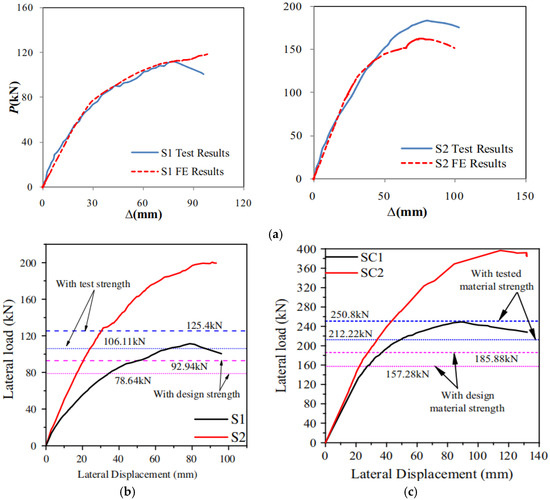
Figure 6.
Load-displacement under static loading. (a) Khan et al. [42]; (b) Chen et al. [45]; (c) Chen et al. [46].
Under static loading, for all of the connections discussed above, local buckling or failure is the primary cause of component failure. This phenomenon remains the same for stiffened and unstiffened joints. Therefore, further research is required to investigate the stiffness and bending capacity of the joints.
3.2. Mechanical Behaviors under Cyclic Loading
To evaluate the overall seismic performance of modular steel buildings under cyclic loading, the component should have sufficient energy dissipation capacity to ensure the safety of the building [68]. Lee et al. [40,41] observed that installation of a shim plate increased the energy absorption capability or the area of the hysteresis curve, as shown in Figure 7a. Dai et al. [36] proposed a self-locking connection; for specimens with rib stiffeners, the hysteresis curve appears fuller, as shown in Figure 7b. Zhai et al. [47] found that the strain gauge reading at the beam end in the joint domain indicates the protective effect of the diagonal stiffening ribs. Large strains were concentrated at the flange positions of the diagonal brace reinforcement; this was caused by the force transfer between the beam-columns along the diagonal braces, as shown in Figure 7c. A new vertical post-tensioning connection was proposed by Sanches et al. [32], who found that the hysteresis curve became narrower as the post-tension load level increased, as shown in Figure 7d. Chen et al. [49] carried out cyclic load tests on QS3 specimens with stiffening ribs; the yield strength and corresponding lateral displacement were 80 kN and 22 mm, respectively. At the end of this cycle, the column end load dropped to 134 kN, which is approximately 85% of the maximum load, as shown in Figure 7e. Srisangeerthanan et al. [35]. applied cyclic shear loads to this innovative connection. The cyclic behavior of the system was satisfactory, and the overall response was elastic, as shown in Figure 7f.
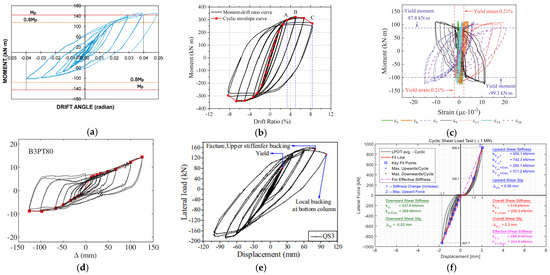
Figure 7.
Hysteresis curves from different studies. (a) Lee et al. [40,41]; (b) Dai et al. [36]; (c) Zhai et al. [47]; (d) Sanches et al. [32]; (e) Chen et al. [45]; (f) Srisangeerthanan et al. [35].
4. Simplified Analytical Models
4.1. Simplified Mechanical Models
Finite element analysis is performed using the commercial software ABAQUS to further understand the mechanical behavior of the connections between modules, which is difficult to guarantee. Thus, a reasonable simplified mechanical model is developed, i.e., a better representation of the properties of the module-to-module connection. The simplified models available in the literature for the mechanical analysis of the connection between modules are listed in Table 4. Chua et al. [29,30] used spring elements to replace the horizontal and vertical connections for modeling. Zhai et al. [47] proposed using springs to replace diagonal braces in the module-to-module connections for modeling. Similar methods can be found in the modeling of the connection by Chen et al. [20] Spring models can define the semi-rigidity and non-linearity of the connections; they are therefore popular when creating connections between modules. Forces or moments can be incorporated into the finite element model by defining the stiffness of the spring. Moreover, the complexity of the model can be reduced by using the spring model. The details of the connection are omitted and the model calculations are considerably less difficult, meaning that it is able to quickly obtain the predicted results.
The modeling of the bolted connection is typically achieved through the direct method of using solid brick elements, which can simulate the actual deformation state. However, this technique greatly increases the complexity of the modeling process. Xu and Ye et al. [69,70] introduced a simplified method using "cartesian" connection elements to model interface bolted connections. The mechanical behavior of this type of joint element is defined by the combination of “elasticity” and “plasticity” behaviors in the longitudinal and transverse shearing directions of the bolt connections. The method of the simplified model can greatly improve the efficiency of numerical analysis and maintain the accuracy of the model. These studies demonstrate the efficiency of using finite element analysis in simulating connections between modules, a finding with significance for the development of modular steel buildings.

Table 4.
Simplified mechanical models of modular steel buildings.
Table 4.
Simplified mechanical models of modular steel buildings.
| Type | Detailed Model | Simplified Model |
|---|---|---|
| Chua et al. [29,30] | 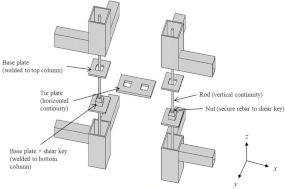 | 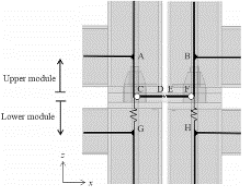 |
| Zhai et al. [47] | 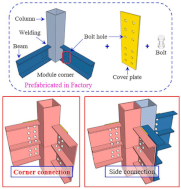 |  |
| Chen et al. [20] | 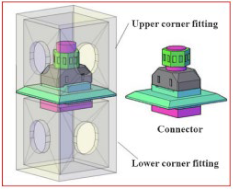 | 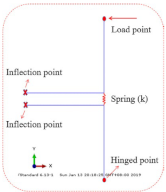 |
4.2. Simplified Calculation Models
It is crucial to establish a simplified calculation model to derive the theoretical equations for connections in modular steel building, especially for complicated inter-module connections. Most investigations on inter-module connections assume that module-to-module connections are ideally pinned or rigid and in the elastic stage. However, these assumptions about inter-module connections may not accurately reflect the actual performance of connections in modular steel buildings, as the load distribution of connections between modules largely depends on the connection behaviors. Therefore, several simplified calculation models have been proposed in previous research on module-to-module connections, as shown in Table 5. Lee et al. [40] assumed cruciform and cantilever specimens as linear elements and evaluated the bending moments applied to the area of connection based on the force balance equations. Chen and Dai et al. [20,36] derived the bending moment equation for the inter-module connection by simplifying the calculation model. Choi et al. [39] proposed a simplified calculation model, in which the rotational stiffness was replaced by rotational spring elements, and an expression was derived for the lateral displacement of the column top. Deng et al. [54,55,56] established a simplified calculation model for inter-module connections and derived expressions for the shear forces in the connection panel area, the connection plate, and the cover plate; they showed that the shear resistance was higher than the shear force acting on the panel area, and that the connection would be dominated by the bending moment. Xu et al. [26,27] developed a simplified mechanical model for a modular steel frame and derived the lateral displacement expression of the column top and the initial lateral stiffness expression of the specimen. Zhai et al. [47] stablished a simplified model for the bending deformation of modular beams, which is divided into the elastic bending and plastic bending sections. The difference between the calculated joint rotation angle, θ5, and θ1 is less than 15%.

Table 5.
Simplified calculation models of modular steel buildings.
5. Prospects of Mechanical Connections in Modular Steel Buildings
Significant progress has been made in the research of connections in modular steel buildings. However, the existing methods of creating inter-module connections have some shortcomings. To address these issues, several scholars have begun to introduce self-locking connection technology into the design and manufacturing of connections in modular steel buildings. However, the mechanical performance and deformation capability of self-locking connections have not been widely studied and require further research.
In addition, the research results of Li and Annal et al. [71,72,73,74] indicate that the load-transferring mechanism of traditional modular steel buildings differs significantly from that of traditional steel frame structures due to the novel construction method. The modules individually withstood various forces with only corner connections, and the mechanical characteristics of the entire modular steel building can only be attributed to the corner connections. Therefore, the behavior of beam components and joints is independent, and it is difficult for the integrity of modular steel buildings to meet the requirements of mid-to-high rise buildings. Several scholars have conducted studies on the joint action of adjacent components in modular steel buildings. Sharafi et al. [37] developed an innovative interlocking system to assemble modules with a set of interconnections in columns and beam units to improve the overall stability of multi-story modular buildings. The robustness of the system was verified through finite element analysis. Xu et al. [5] studied the bending response of laminated double-channel beams with bolted connections through tests and simulations. The results show that modular laminated double beams work together during bending, and cross-sectional stress patterns are highly dependent on interface slip values. Peng et al. [75] proposed a configuration of laminated parallel flange channels combined with an integrated concrete slab, which can improve the flexural rigidity of the floor system. However, research on the connection behavior of double beams in modular steel building is still limited, and further research is needed in the future to study the overall bending capacity and the bending mechanism of double beams.
The above findings show that the development of self-locking connections between modules and the mechanical performance of double beams are important challenges that require further research in the future. Additionally, the demand for housing is constantly increasing with the continuous updating and development of modern building technology. Modular buildings have a unique layout and design concept, with broad applications prospects and significant development potential. Therefore, modular steel buildings are considered to represent the future of building development.
6. Conclusions
This study presented an overview of the joints of inter-module connections in modular steel buildings. The existing module-to-module connections were evaluated through a detailed five-chapter review. The main points of the critical review presented in this paper are summarized as follows:
- The structural forms of vertical and horizontal connections between modules were classified. Additionally, the connections between concrete and modules were summarized for high-rise modular steel buildings to provide a reference for subsequent research on the mechanical performance of high-rise modular steel buildings.
- Mechanical models and design formulas are the key to engineering applications. The load-bearing mechanisms of the joints used in module-to-module connections were summarized, and various design formulas were presented, providing a basis for the use of theoretical formulas related to inter-module connections.
- The existing simplified mechanical models of inter-module connections were systematically reviewed. Spring modelling methods, instead of connector methods, and "cartesian" connection units, instead of bolted connections, were summarized with the aim of improving the efficiency and accuracy of joint modelling. This provides a reference for the subsequent parametric analysis of inter-module connections.
- The methods of module-to-module connection were explored. Although many studies have been carried out on the joints used in inter-module connections, these joints do not allow for fully modular buildings, and their carrying capacity is not fully realized. Thus, this paper suggests two future research directions: self-locking connections and connections on double laminated beams.
Author Contributions
C.Y. written the manuscript. B.X. and J.X. put forward the concept of the work and designed the investigation. H.C. and X.C. made the contributions to the collection of literature. R.M. edited the language of the manuscript. All authors have read and agreed to the published version of the manuscript.
Funding
This work was financially supported by the National Natural Science Foundation of China (Grant no. 52208145, 52074270, 51978657) and the Major research fund of JiangSu Collaborative Innovation Center for Building Energy Saving and Construction Technology (Grant no. SJXTZD2106, SJXTGJ2101).
Data Availability Statement
The data presented in this study are available on request form the authors.
Conflicts of Interest
The authors declare no conflict of interest.
References
- Chen, Z.; Wang, J.; Liu, J.; Khan, K. Seismic behavior and moment transfer capacity of an innovative self-locking inter-module connection for modular steel building. Eng. Struct. 2021, 245, 112978. [Google Scholar] [CrossRef]
- Lacey, A.W.; Chen, W.S.; Hao, H. Structural response of modular buildings—An overview. J. Build. Eng. 2018, 16, 45–56. [Google Scholar] [CrossRef]
- Ma, R.; Xia, J.; Chang, H.; Xu, B.; Zhang, L. Experimental and numerical investigation of mechanical properties on novel modular connections with superimposed beams. Eng. Struct. 2021, 232, 111858. [Google Scholar] [CrossRef]
- Gunawardena, T. Behaviour of Prefabricated Modular Buildings Subjected to Lateral Loads. Doctoral Thesis, The University of Melbourne, Melbourne, Australia, 2016. [Google Scholar]
- Xu, B.; Xia, J.; Chang, H.; Ma, R.; Zhang, L. A comprehensive experimental-numerical investigation on the bending response of laminated double channel beams in modular buildings. Eng. Struct. 2019, 200, 109737. [Google Scholar] [CrossRef]
- Lee, S.; Park, J.; Shon, S.; Kang, C. Seismic performance evaluation of the ceiling-bracket-type modular joint with various bracket parameters. J. Constr. Steel Res. 2018, 150, 298–325. [Google Scholar] [CrossRef]
- Nadeem, G.; Safiee, N.A.; Bakar, N.A.; Abd Karim, I.; Nasir, N.A. Connection design in modular steel construction: A review. Structures 2021, 33, 3239–3256. [Google Scholar] [CrossRef]
- Xu, B.; Xia, J.; Chang, H.; Ma, R.; Zhang, L. Flexural behaviour of pairs of laminated unequal channel beams with different interfacial connections in corner-supported modular steel buildings. Thin-Walled Struct. 2020, 154, 106792. [Google Scholar] [CrossRef]
- Chen, Z.; Khan, K.; Khan, A.; Javed, K.; Liu, J. Exploration of the multidirectional stability and response of prefabricated volumetric modular steel structures. J. Constr. Steel Res. 2021, 184, 106826. [Google Scholar] [CrossRef]
- Lawson, R.M.; Richards, J. Modular design for high-rise buildings. Proc. Inst. Civ. Eng.-Struct. Build. 2010, 163, 151–164. [Google Scholar] [CrossRef]
- Li, A.Q.; Zhou, T.; Miao, Z.W. State of the art of modular building system. Ind. Constr. 2018, 48, 132–139+150. [Google Scholar]
- Zhao, F.; Yu, Y.; Lin, S.; Ding, F. Evaluation of the working mechanisms and simplified models of endplate-type inter-module connections. Structures 2021, 32, 562–577. [Google Scholar] [CrossRef]
- Deng, E.F.; Zong, L.; Ding, Y.; Zhang, Z.; Zhang, J.F.; Shi, F.W.; Cai, L.M.; Gao, S.C. Seismic performance of mid-to-high rise modular steel construction—A critical review. Thin-Walled Struct. 2020, 155, 106924. [Google Scholar] [CrossRef]
- Lawson, R.M.; Ogden, R.G. ‘Hybrid’ light steel panel and modular systems. Thin-Walled Struct. 2008, 46, 720–730. [Google Scholar] [CrossRef]
- Lacey, A.W.; Chen, W.; Hao, H.; Bi, K. Review of bolted inter-module connections in modular steel buildings. J. Build. Eng. 2019, 23, 207–219. [Google Scholar] [CrossRef]
- Ferdous, W.; Bai, Y.; Ngo, T.D.; Manalo, A.; Mendis, P. New advancements, challenges and opportunities of multi-storey modular buildings—A state-of-the-art review. Eng. Struct. 2019, 183, 883–893. [Google Scholar] [CrossRef]
- Wang, Z.; Tsavdaridis, K.D. Optimality criteria-based minimum-weight design method for modular building systems subjected to generalised stiffness constraints: A comparative study. Eng. Struct. 2022, 251, 113472. [Google Scholar] [CrossRef]
- Davies, C. The Prefabricated Home; Reaktion Books: London, UK, 2005. [Google Scholar]
- Dai, X.M. Research on Seismic Behavior and Desgin Method of Self-Lock Plug-In Joints in Modular Steel Construction. Doctoral Thesis, Tianjin University, Tianjin, China, 2019. [Google Scholar]
- Chen, Z.; Liu, Y.; Zhong, X.; Liu, J. Rotational stiffness of inter-module connection in mid-rise modular steel buildings. Eng. Struct. 2019, 196, 109273. [Google Scholar] [CrossRef]
- Kurakawa, K. Kisho Kurakawa; Rizzoli Press: New York, NY, USA, 1988. [Google Scholar]
- Schmal, P.C.; Visscher, J.; Flagge, I.; Deutsches, A. Kisho Kurokawa: Metabolism and Sysbiosis; Jovis Verlag: Berlin, Germany, 2005. [Google Scholar]
- Chen, Z.; Wang, J.; Liu, J.; Cong, Z. Tensile and shear performance of rotary inter-module connection for modular steel buildings. J. Constr. Steel Res. 2020, 175, 106367. [Google Scholar] [CrossRef]
- Corfar, D.A.; Tsavdaridis, K.D. A comprehensive review and classification of inter-module connections for hot-rolled steel modular building systems. J. Build. Eng. 2022, 50, 104006. [Google Scholar] [CrossRef]
- Srisangeerthanan, S.; Hashemi, M.J.; Rajeev, P.; Gad, E.; Fernando, S. Review of performance requirements for inter-module connections in multi-story modular buildings. J. Build. Eng. 2020, 28, 101087. [Google Scholar] [CrossRef]
- Xu, B.; Xia, J.; Chang, H.; Ma, R.; Zhang, L. Evaluation of superimposed bending behaviour of laminated channel beams in modular steel buildings subjected to lateral load. Thin-Walled Struct. 2022, 175, 109234. [Google Scholar] [CrossRef]
- Xu, B.; Xia, J.; Chang, H.; Ma, R.; Zhang, L. Experimental and numerical investigation on the lateral force resistance of modular steel sub-frames with laminated double beam. J. Build. Eng. 2022, 46, 103666. [Google Scholar] [CrossRef]
- Lacey, A.W.; Chen, W.; Hao, H.; Bi, K.; Tallowin, F.J. Shear behaviour of post-tensioned inter-module connection for modular steel buildings. J. Constr. Steel Res. 2019, 162, 105707. [Google Scholar] [CrossRef]
- Chua, Y.S.; Liew, J.R.; Pang, S.D. Modelling of connections and lateral behavior of high-rise modular steel buildings. J. Constr. Steel Res. 2020, 166, 105901. [Google Scholar] [CrossRef]
- Chua, Y.S.; Dai Pang, S.; Liew, J.R.; Dai, Z. Robustness of inter-module connections and steel modular buildings under column loss scenarios. J. Build. Eng. 2022, 47, 103888. [Google Scholar] [CrossRef]
- Chen, Z.; Li, H.; Chen, A.; Yu, Y.; Wang, H. Research on pretensioned modular frame test and simulations. Eng. Struct. 2017, 151, 774–787. [Google Scholar] [CrossRef]
- Sanches, R.; Mercan, O.; Roberts, B. Experimental investigations of vertical post-tensioned connection for modular steel structures. Eng. Struct. 2018, 175, 776–789. [Google Scholar] [CrossRef]
- Lacey, A.W.; Chen, W.; Hao, H.; Bi, K. Lateral behaviour of modular steel building with simplified models of new inter-module connections. Eng. Struct. 2021, 236, 112103. [Google Scholar] [CrossRef]
- Dai, Z.; Cheong, T.C.; Dai Pang, S.; Liew, J.R. Experimental study of grouted sleeve connections under bending for steel modular buildings. Eng. Struct. 2021, 243, 112614. [Google Scholar] [CrossRef]
- Srisangeerthanan, S.; Hashemi, M.J.; Rajeev, P.; Gad, E.; Fernando, S. Development of an Innovative Boltless Connection for Multistory Modular Buildings. J. Struct. Eng. 2022, 148, 04022085. [Google Scholar] [CrossRef]
- Dai, X.M.; Zong, L.; Ding, Y.; Li, Z.X. Experimental study on seismic behavior of a novel plug-in self-lock joint for modular steel construction. Eng. Struct. 2019, 181, 143–164. [Google Scholar] [CrossRef]
- Sharafi, P.; Mortazavi, M.; Samali, B.; Ronagh, H. Interlocking system for enhancing the integrity of multi-storey modular buildings. Autom. Constr. 2018, 85, 263–272. [Google Scholar] [CrossRef]
- Liu, X.C.; Cui, F.Y.; Zhan, X.X.; Yu, C.; Jiang, Z.Q. Seismic performance of bolted connection of H-beam to HSS-column with web end-plate. J. Constr. Steel Res. 2019, 156, 167–181. [Google Scholar] [CrossRef]
- Choi, K.S.; Lee, H.C.; Kim, H.J. Influence of Analytical Models on the Seismic Response of Modular Structures. J. Korea Inst. Struct. Maint. Insp. 2016, 20, 74–85. [Google Scholar]
- Lee, S.; Park, J.; Kwak, E.; Shon, S.; Kang, C.; Choi, H. Verification of the Seismic Performance of a Rigidly Connected Modular System Depending on the Shape and Size of the Ceiling Bracket. Materials 2017, 10, 263. [Google Scholar] [CrossRef]
- Lee, S.S. Finite Element Modeling of Bolted Inter-Module Connections in Modular Steel Buildings. J. Korean Soc. Steel Constr. 2021, 33, 347–354. [Google Scholar] [CrossRef]
- Khan, K.; Yan, J.B. Finite Element Analysis on Seismic Behaviour of Novel Joint in Prefabricated Modular Steel Building. Int. J. Steel Struct. 2020, 20, 752–765. [Google Scholar] [CrossRef]
- Nadeem, G.; Safiee, N.A.; Abu Bakar, N.; Karim, I.A.; Nasir, N.A.M. Finite Element Analysis of Proposed Self-Locking Joint for Modular Steel Structures. Appl. Sci. 2021, 11, 9277. [Google Scholar] [CrossRef]
- Wang, Y.R.; Xia, J.W.; Ma, R.W. Experimental Study on the Flexural Behavior of an Innovative Modular Steel Building Connection with Installed Bolts in the Columns. Appl. Sci. 2019, 9, 3468. [Google Scholar] [CrossRef]
- Chen, Z.; Liu, J.; Yu, Y.; Zhou, C.; Yan, R. Experimental study of an innovative modular steel building connection. J. Constr. Steel Res. 2017, 139, 69–82. [Google Scholar] [CrossRef]
- Chen, Z.H.; Liu, J.D.; Yu, Y.J. Experimental study on interior connections in modular steel buildings. Eng. Struct. 2017, 147, 625–638. [Google Scholar] [CrossRef]
- Zhai, S.Y.; Lyu, Y.F.; Cao, K.; Li, G.Q.; Wang, W.Y.; Chen, C. Experimental study on bolted-cover plate corner connections for column-supported modular steel buildings. J. Constr. Steel Res. 2022, 189, 107060. [Google Scholar] [CrossRef]
- Xu, L.H.; Yang, X.L.; Zhang, G. Study on mechanical behavior of plug-in connection for a novel modular steel structure. Eng. Mech. 2022, 39, 1–10. [Google Scholar]
- Zhang, G.; Xu, L.-H.; Li, Z.-X. Development and seismic retrofit of an innovative modular steel structure connection using symmetrical self-centering haunch braces. Eng. Struct. 2021, 229, 111671. [Google Scholar] [CrossRef]
- Lyu, Y.F.; Li, G.Q.; Cao, K.; Zhai, S.Y.; Wang, Y.B.; Mao, L.; Ran, M.M. Bending behavior of splice connection for corner-supported steel modular buildings. Eng. Struct. 2022, 250, 113460. [Google Scholar] [CrossRef]
- Deng, E.F.; Yan, J.B.; Ding, Y.; Zong, L.; Li, Z.X.; Dai, X.M. Analytical and numerical studies on steel columns with novel connections in modular construction. Int. J. Steel Struct. 2017, 17, 1613–1626. [Google Scholar] [CrossRef]
- Styles, A.J.; Luo, F.J.; Bai, Y.; Murray-Parkes, J.B. Effects of joint rotational stiffness on structural reponses of multi-story modular buildings. In Proceedings of the International Conference on Smart Infrastructure and Construction (ICSIC), Cambridge, UK, 27–29 June 2016. [Google Scholar]
- Bazarchi, E.; Davaran, A.; Lamarche, C.; Roy, N.; Parent, S. Experimental and numerical investigation of a novel vertically unconstrained steel inter-modular connection. Thin-Walled Struct. 2023, 183, 110364. [Google Scholar] [CrossRef]
- Deng, E.F.; Zong, L.; Ding, Y. Mechanical properties of innovative connection for integrated modular steel construction. J. Tianjin Univ. Sci. Technol. 2018, 51, 702–710. [Google Scholar]
- Deng, E.F.; Lian, J.Y.; Liu, Z.; Zhang, G.C.; Wang, S.B.; Cao, D.B. Compressive Behavior of a Fully Prefabricated Liftable Connection for Modular Steel Construction. Buildings 2022, 12, 649. [Google Scholar] [CrossRef]
- Deng, E.F.; Zong, L.; Ding, Y.; Luo, Y.B. Seismic behavior and design of cruciform bolted module-to-module connection with various reinforcing details. Thin-Walled Struct. 2018, 133, 106–119. [Google Scholar] [CrossRef]
- Shi, F.; Wang, H.; Zong, L.; Ding, Y.; Su, J. Seismic behavior of high-rise modular steel constructions with various module layouts. J. Build. Eng. 2020, 31, 101396. [Google Scholar] [CrossRef]
- Lacey, A.W.; Chen, W.; Hao, H.; Bi, K. New interlocking inter-module connection for modular steel buildings: Experimental and numerical studies. Eng. Struct. 2019, 198, 109465. [Google Scholar] [CrossRef]
- Lacey, A.W.; Chen, W.; Hao, H.; Bi, K. New interlocking inter-module connection for modular steel buildings: Simplified structural behaviours. Eng. Struct. 2021, 227, 111409. [Google Scholar] [CrossRef]
- Nadeem, G.; Safiee, N.A.; Abu Bakar, N.; Karim, I.A.; Nasir, N.A.M. Evaluation of slip behaviour of self-locking modular steel connection. J. Constr. Steel Res. 2022, 197, 107467. [Google Scholar] [CrossRef]
- Zhong, X.; Chen, Z.; Liu, J.; Liu, Y.; Liu, X. Experimental research on the in-plane performance of discontinuous modular diaphragms. Thin-Walled Struct. 2022, 173, 108905. [Google Scholar] [CrossRef]
- Fathieh, A.; Mercan, O. Seismic evaluation of modular steel buildings. Eng. Struct. 2016, 122, 83–92. [Google Scholar] [CrossRef]
- Gorgolewski, M.T.; Grubb, P.J.; Lawson, R.M. Modular Construction Using Light Steel Framing: Design of Residential Buildings; The Steel Construction Institute: Berkshire, UK, 2001. [Google Scholar]
- Choi, Y.H.; Lee, H.C.; Kim, J.K. Seismic Performance Assessment of a Modular System with Composite Section. J. Korea Inst. Struct. Maint. Insp. 2017, 21, 69–77. [Google Scholar]
- Ping, T.Y.; Pan, W.; Mou, B. An innovative type of module-to-core wall connections for high- rise steel modular buildings. J. Build. Eng. 2022, 62, 105425. [Google Scholar] [CrossRef]
- Chen, Z.; Zhong, X.; Liu, Y.; Liu, J. Analytical and Design Method for the Global Stability of Modular Steel Buildings. Int. J. Steel Struct. 2021, 21, 1741–1758. [Google Scholar] [CrossRef]
- He XH, C.; Chan, T.M.; Chung, K.F. Effect of inter-module connections on progressive collapse behaviour of MiC structures. J. Constr. Steel Res. 2021, 185, 106823. [Google Scholar]
- Zhai, S.Y.; Lyu, Y.F.; Cao, K.; Li, G.Q.; Wang, W.Y.; Chen, C. Seismic behavior of an innovative bolted connection with dual-slot hole for modular steel buildings. Eng. Struct. 2023, 279, 115619. [Google Scholar] [CrossRef]
- Xu, B.; Xia, J.; Ma, R.; Chang, H.; Yang, C.; Zhang, L. Investigation on interfacial slipping response of laminated channel beams with bolt connections in modular steel buildings. J. Build. Eng. 2023, 63, 105441. [Google Scholar] [CrossRef]
- Ye, J.; Mojtabaei, S.M.; Hajirasouliha, I.; Shepherd, P.; Pilakoutas, K. Strength and deflection behaviour of cold-formed steel back-to-back channels. Eng. Struct. 2018, 177, 641–654. [Google Scholar] [CrossRef]
- Annan, C.; Youssef, M.; El Naggar, M. Experimental evaluation of the seismic performance of modular steel-braced frames. Eng. Struct. 2009, 13, 1435–1446. [Google Scholar] [CrossRef]
- Annan, C.D.; Youssef, M.A.; El Naggar, M.H. Seismic vulnerability assessment of modular steel buildings. J. Earthq. Eng. 2009, 13, 1065–1088. [Google Scholar] [CrossRef]
- Annan, C.D.; Youssef, M.A.; El Naggar, M.H. Seismic Overstrength in Braced Frames of Modular Steel Buildings. J. Earthq. Eng. 2008, 13, 1–21. [Google Scholar] [CrossRef]
- Li, G.Q.; Cao, K.; Lu, Y.; Jiang, J. Effective length factor of columns in non-sway modular steel buildings. Adv. Steel Constr. 2017, 13, 412–426. [Google Scholar]
- Peng, J.H.; Hou, C.; Shen, L.M. Numerical analysis of corner-supported composite modular buildings under wind actions. J. Constr. Steel Res. 2021, 187, 412–426. [Google Scholar] [CrossRef]
Disclaimer/Publisher’s Note: The statements, opinions and data contained in all publications are solely those of the individual author(s) and contributor(s) and not of MDPI and/or the editor(s). MDPI and/or the editor(s) disclaim responsibility for any injury to people or property resulting from any ideas, methods, instructions or products referred to in the content. |
© 2023 by the authors. Licensee MDPI, Basel, Switzerland. This article is an open access article distributed under the terms and conditions of the Creative Commons Attribution (CC BY) license (https://creativecommons.org/licenses/by/4.0/).
